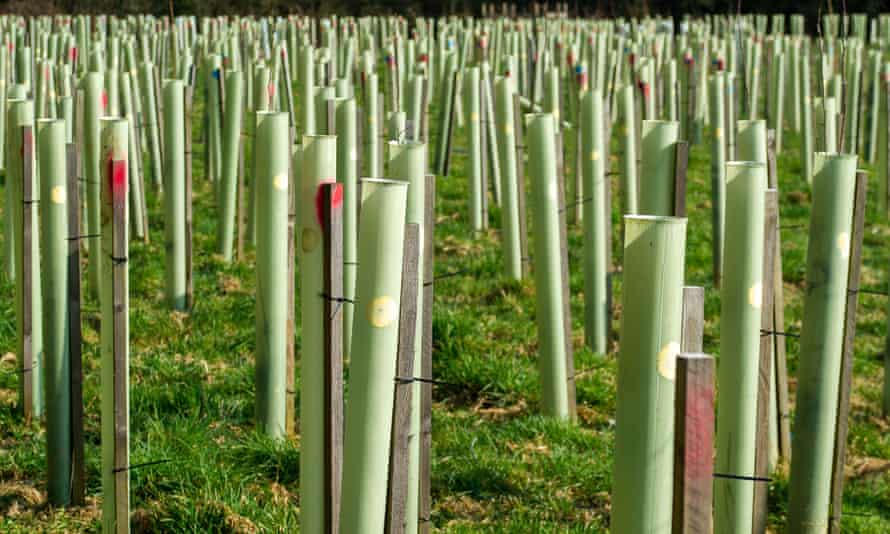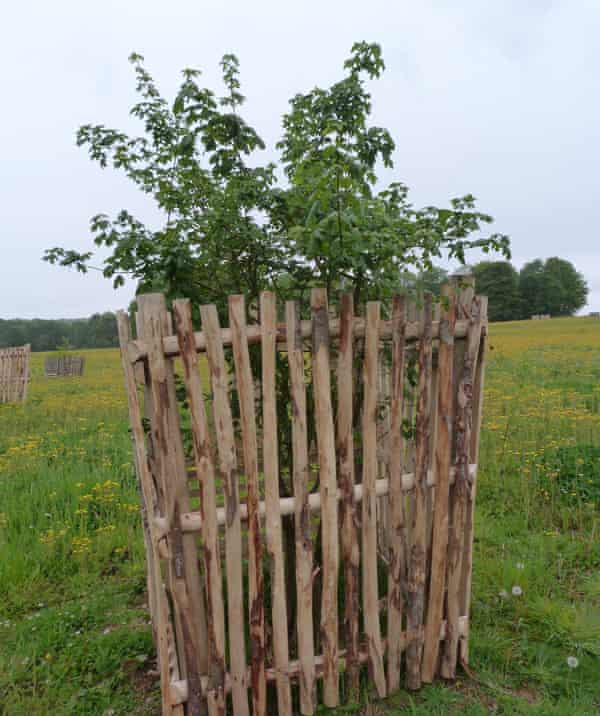Planting trees without plastic tree guards should be standard practice, a UK study has found, as leading conservation charities and landowners seek sustainable alternatives to reduce plastic waste.
The Woodland Trust has announced it is aiming to stop using plastic tree guards by the end of the year. It is trialling plastic-free options at its Avoncliff site in Wiltshire, including cardboard and British wool. The charity plans to plant 10 million trees each year until 2025.
Darren Moorcroft, chief executive of the Woodland Trust, said: “As one of the nation’s largest tree planters, by committing to go plastic-free in terms of the use of tree shelters, we are set to be the trailblazers in this field – catalysing a permanent change to the tree-planting world.”
Since the 1970s, saplings have generally been planted in translucent plastic tubes to protect them from being eaten by browsing animals. However, the research – which analysed the lifecycle of the plastic and trees – found it was better to lose a certain percentage of saplings than use plastic guards to protect them.
This is because there are significant carbon emissions from the manufacture of the guards, and they are rarely collected after use, meaning they break down into microplastics, polluting the natural environment and harming wildlife.

The UK’s independent climate advisory body has recommended increasing national forest cover from 13% to up to 19% by 2050, which the Woodland Trust equates to planting more than 1.5 billion trees.
The study, published in Science of the Total Environment, warned: “Mass planting of trees to fulfil the net zero targets could therefore entail a substantial amount of plastic tree shelters to be manufactured and left unrecovered in the environment.”
On average, 85% of trees with shelters survive, while 50% survive if no shelter is used, scientists found. This means to get one tree to the point of being established at five years, surviving into adulthood, you would have to plant 1.18 trees if using shelters and two trees without shelters. Rather than using tree guards to obtain a higher survival rate of saplings, scientists concluded that it was better for the environment to go plastic-free.
Best practice depends on location, and in areas with very high levels of damage by grazing animals such as rabbits, deer and sheep, the study found it was better to use tree guards.
Prof Mark Miodownik from University College London and one of the paper’s authors said: “Start with the premise you’re not going to use plastic tree guards. Use them if it’s the only feasible way to protect the trees in that location.
“We have an established practice of using tree guards and we couldn’t find any real evidence where anyone had carefully calculated the impacts of either scenario. Now we’ve done it, and what we showed is that you can manage the land in a different way.”

Analysis focused on data from the Woodland Trust’s reforestation efforts in the UK but scientists say the results are valid for other temperate oceanic regions. The most common afforestation strategy is to grow young trees in nurseries until they are between four months and three years old. Plastic tubes are generally designed to last for at least five years during the trees “establishment period”, after which survival rate is about 99%.
After this period, tree guards are generally left to degrade because it is cost-inefficient and time-consuming to collect and recycle them. It would be better if people recycled them, but in practice they become brittle and entangled in vegetation, shattering easily when pulled out.
Even if a shelter is collected and recycled, the carbon footprint of planting the tree is at least double that of plastic-free planting, the researchers found. Miodownik said: “We can’t have a solution that looks great but is creating lots of hidden CO2 emissions.”
The National Trust – which is among the biggest landowners in the country – aims to plant 20 million trees by 2030 and is testing sustainable alternatives to plastic guards, including using crates built from local diseased trees, cardboard tubes and using other shrubs such as gorse and hawthorn to protect saplings.

On the South Downs, the trust has used crates made from sweet chestnut collected from nearby. Each one can contain up to 20 saplings. They are time-consuming to construct but are robust and aesthetic to the surrounding landscape.
In Somerset, 6,000 cardboard tubes have been used as part of a two-year tree-planting programme. But with 40% needing to be replaced due to damage caused by animals and heavy wind and rain they are unlikely to be a long-term solution. Other options include natural protection with gorse or wooden fencing.
In Ennerdale, in the Lake District, the trust has used the brash from felled conifer trees to protect 20,000 native trees planted as part of a project to create more mixed woodland in the valley.
The rewilding approach of natural regeneration appears to work, but there is not much data on the success rate, and researchers did not examine this as part of the study.
“This is not the last word on this, this is the beginning of an evidence-based approach to planting trees,” said Miodownik. “The next generation will have to be the custodians of large forests, which have to be maintained and kept alive. I think working out how to do that is a skill.”
Find more age of extinction coverage here, and follow biodiversity reporters Phoebe Weston and Patrick Greenfield on Twitter for all the latest news and features


Average Rating